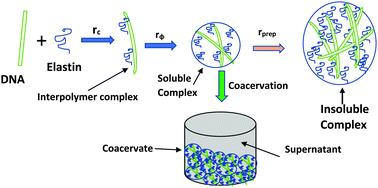当前位置:
X-MOL 学术
›
Soft Matter
›
论文详情
Our official English website, www.x-mol.net, welcomes your feedback! (Note: you will need to create a separate account there.)
Ubiquity of complex coacervation of DNA and proteins in aqueous solution.
Soft Matter ( IF 3.4 ) Pub Date : 2020-09-01 , DOI: 10.1039/d0sm00543f Priyanka Kaushik 1 , Pankaj K Pandey 2 , V K Aswal 3 , H B Bohidar 1
Soft Matter ( IF 3.4 ) Pub Date : 2020-09-01 , DOI: 10.1039/d0sm00543f Priyanka Kaushik 1 , Pankaj K Pandey 2 , V K Aswal 3 , H B Bohidar 1
Affiliation

|
We report complex coacervation between a primarily hydrophobic protein, elastin, and a strong polyanion DNA (2 kbp) in aqueous and salty solutions at room temperature, 25 °C. The associative interaction at fixed elastin and varying DNA concentration, thereby maintaining a mixing ratio of r = [DNA] : [elastin] = 0.0027 to 0.093, was probed. What distinguishes this study from protein–DNA coacervation reported earlier is that the protein used here was mostly a hydrophobic polyampholyte with low linear charge density, and its complementary polyelectrolyte, DNA, concentration was chosen to be extremely small (1–35 ppm). The interaction profile was found to be strongly hierarchical in the mixing ratio, defined by three distinct regions: (i) Region I (r < 0.02) was defined as the onset of primary binding leading to condensation of DNA; (ii) Region II (0.02 < r < 0.08) indicated secondary binding which led to the formation of fully charge neutralized complexes signaling the onset of coacervation; and (iii) Region III (0.08 < r < 0.12) revealed growth of insoluble complexes of large size facilitating liquid–solid phase separation. The degree of complex coacervation was suppressed in the presence of a monovalent salt implying that screened Coulomb interactions governed the binding. Small angle neutron scattering data attributed an amorphous structure to the coacervates. The elastin–DNA system belongs to a rare class of interacting biopolymers where very weak electrostatic interactions may drive coacervation, thereby implying that coacervation between DNA and proteins may be ubiquitous.
中文翻译:

水溶液中DNA和蛋白质复杂凝聚的普遍性。
我们报告了在室温和25°C的水溶液和咸溶液中,主要疏水蛋白,弹性蛋白和强聚阴离子DNA(2 kbp)之间的复杂凝聚。探索在固定的弹性蛋白和变化的DNA浓度下的缔合相互作用,从而维持r= [DNA]:[弹性蛋白] = 0.0027至0.093的混合比。这项研究与之前报道的蛋白质-DNA凝聚的区别在于,此处使用的蛋白质主要是具有低线性电荷密度的疏水性聚两性电解质,而其互补的聚电解质DNA的浓度被选择为极小(1-35 ppm)。发现相互作用曲线在混合比中具有很强的层次性,由三个不同的区域定义:(i)区域I(r<0.02)被定义为导致DNA缩合的主要结合的开始; (ii)II区(0.02 < r <0.08)表示次级结合,导致形成完全电荷的中和复合物,表明凝聚开始。和(iii)第三区(0.08 < r<0.12)揭示了大尺寸不溶性复合物的生长,促进了液相-固相分离。在单价盐的存在下,复合凝聚的程度受到抑制,这表明筛选的库仑相互作用决定了结合。小角度中子散射数据将非晶结构归因于凝聚层。弹性蛋白-DNA系统属于一类罕见的相互作用的生物聚合物,其中极弱的静电相互作用可能会导致凝聚,因此暗示DNA和蛋白质之间的凝聚可能无处不在。
更新日期:2020-09-23
中文翻译:

水溶液中DNA和蛋白质复杂凝聚的普遍性。
我们报告了在室温和25°C的水溶液和咸溶液中,主要疏水蛋白,弹性蛋白和强聚阴离子DNA(2 kbp)之间的复杂凝聚。探索在固定的弹性蛋白和变化的DNA浓度下的缔合相互作用,从而维持r= [DNA]:[弹性蛋白] = 0.0027至0.093的混合比。这项研究与之前报道的蛋白质-DNA凝聚的区别在于,此处使用的蛋白质主要是具有低线性电荷密度的疏水性聚两性电解质,而其互补的聚电解质DNA的浓度被选择为极小(1-35 ppm)。发现相互作用曲线在混合比中具有很强的层次性,由三个不同的区域定义:(i)区域I(r<0.02)被定义为导致DNA缩合的主要结合的开始; (ii)II区(0.02 < r <0.08)表示次级结合,导致形成完全电荷的中和复合物,表明凝聚开始。和(iii)第三区(0.08 < r<0.12)揭示了大尺寸不溶性复合物的生长,促进了液相-固相分离。在单价盐的存在下,复合凝聚的程度受到抑制,这表明筛选的库仑相互作用决定了结合。小角度中子散射数据将非晶结构归因于凝聚层。弹性蛋白-DNA系统属于一类罕见的相互作用的生物聚合物,其中极弱的静电相互作用可能会导致凝聚,因此暗示DNA和蛋白质之间的凝聚可能无处不在。



























 京公网安备 11010802027423号
京公网安备 11010802027423号